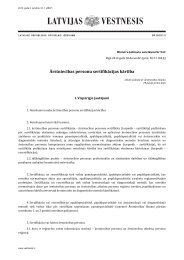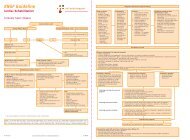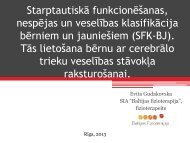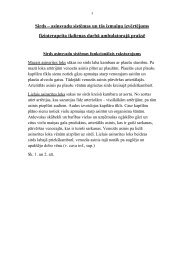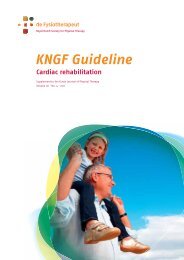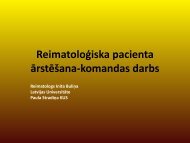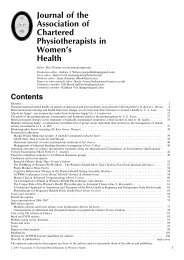You also want an ePaper? Increase the reach of your titles
YUMPU automatically turns print PDFs into web optimized ePapers that Google loves.
<strong>Low</strong> <strong>Back</strong> <strong>Pain</strong>: Clinical Practice Guidelines<br />
RISK FACTORS: Current literature does not support a definitive<br />
cause for initial episodes of low back pain. Risk factors<br />
are multifactorial, population specific, and only weakly<br />
associated with the development of low back pain. (Recommendation<br />
based on moderate evidence.)<br />
CLINICAL COURSE: The clinical course of low back pain can<br />
be described as acute, subacute, recurrent, or chronic. Given<br />
the high prevalence of recurrent and chronic low back pain<br />
and the associated costs, clinicians should place high priority<br />
on interventions that prevent (1) recurrences and (2)<br />
the transition to chronic low back pain. (Recommendation<br />
based on theoretical/foundational evidence.)<br />
DIAGNOSIS/CLASSIFICATION: <strong>Low</strong> back pain, without symptoms<br />
or signs of serious medical or psychological conditions,<br />
associated with clinical findings of (1) mobility impairment<br />
in the thoracic, lumbar, or sacroiliac regions, (2) referred or<br />
radiating pain into a lower extremity, and (3) generalized<br />
pain , is useful for classifying a patient with low back pain<br />
into the following International Statistical Classification of<br />
Diseases and Related Health Problems (ICD) categories:<br />
low back pain, lumbago, lumbosacral segmental/somatic<br />
dysfunction, low back strain, spinal instabilities, flatback<br />
syndrome, lumbago due to displacement of intervertebral<br />
disc, lumbago with sciatica, and the associated International<br />
Classification of Functioning, Disability, and Health (ICF)<br />
impairment-based category of low back pain (b28013 <strong>Pain</strong><br />
in back, b28018 <strong>Pain</strong> in body part, specified as pain in buttock,<br />
groin, and thigh) and the following, corresponding<br />
impairments of body function:<br />
• Acute or subacute low back pain with mobility deficits<br />
(b7101 Mobility of several joints)<br />
• Acute, subacute, or chronic low back pain with movement<br />
coordination impairments (b7601 Control of complex<br />
voluntary movements)<br />
• Acute low back pain with related (referred) lower extremity<br />
pain (b28015 <strong>Pain</strong> in lower limb)<br />
• Acute, subacute, or chronic low back pain with radiating<br />
pain (b2804 Radiating pain in a segment or region)<br />
• Acute or subacute low back pain with related cognitive or<br />
affective tendencies (b2703 Sensitivity to a noxious stimulus,<br />
b1522 Range of emotion, b1608 Thought functions,<br />
specified as the tendency to elaborate physical symptoms<br />
for cognitive/ideational reasons, b1528 Emotional<br />
functions, specified as the tendency to elaborate physical<br />
symptoms for emotional/affective reasons)<br />
Recommendations*<br />
a2 | april 2012 | volume 42 | number 4 | journal of orthopaedic & sports physical therapy<br />
• Chronic low back pain with related generalized pain<br />
(b2800 Generalized pain, b1520 Appropriateness of emotion,<br />
b1602 Content of thought)<br />
DIFFERENTIAL DIAGNOSIS: Clinicians should consider diagnostic<br />
classifications associated with serious medical conditions<br />
or psychosocial factors and initiate referral to the appropriate<br />
medical practitioner when (1) the patient’s clinical<br />
findings are suggestive of serious medical or psychological<br />
pathology, (2) the reported activity limitations or impairments<br />
of body function and structure are not consistent<br />
with those presented in the diagnosis/classification section<br />
of these guidelines, or (3) the patient’s symptoms are not<br />
resolving with interventions aimed at normalization of the<br />
patient’s impairments of body function. (Recommendation<br />
based on strong evidence.)<br />
EXAMINATION – OUTCOME MEASURES: Clinicians should use<br />
validated self-report questionnaires, such as the Oswestry<br />
Disability Index and the Roland-Morris Disability Questionnaire.<br />
These tools are useful for identifying a patient’s<br />
baseline status relative to pain, function, and disability and<br />
for monitoring a change in a patient’s status throughout<br />
the course of treatment. (Recommendation based on strong<br />
evidence.)<br />
EXAMINATION – ACTIVITY LIMITATION AND PARTICIPATION<br />
RESTRICTION MEASURES: Clinicians should routinely assess<br />
activity limitation and participation restriction through<br />
validated performance-based measures. Changes in the<br />
patient’s level of activity limitation and participation restriction<br />
should be monitored with these same measures over<br />
the course of treatment. (Recommendation based on expert<br />
opinion.)<br />
INTERVENTIONS – MANUAL THERAPY: Clinicians should consider<br />
utilizing thrust manipulative procedures to reduce pain<br />
and disability in patients with mobility deficits and acute<br />
low back and back-related buttock or thigh pain. Thrust manipulative<br />
and nonthrust mobilization procedures can also<br />
be used to improve spine and hip mobility and reduce pain<br />
and disability in patients with subacute and chronic low<br />
back and back-related lower extremity pain. (Recommendation<br />
based on strong evidence.)<br />
INTERVENTIONS – TRUNK COORDINATION, STRENGTHENING, AND<br />
ENDURANCE EXERCISES: Clinicians should consider utilizing<br />
trunk coordination, strengthening, and endurance exercises<br />
to reduce low back pain and disability in patients with sub-



